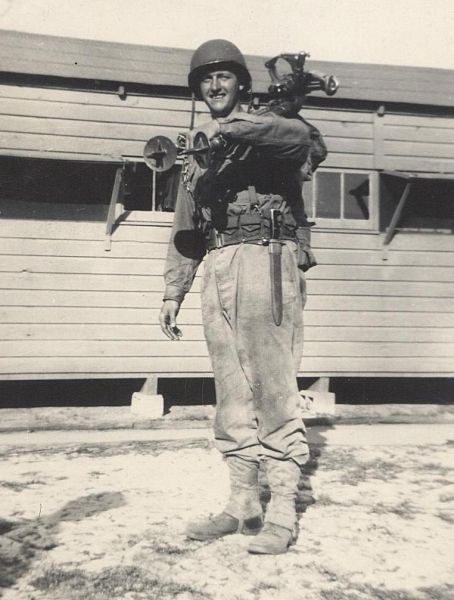Gwinn, Merritt S.
- Date of birth:
- June 15th, 1922 (Wellington, Missouri, United States)
- Date of death:
- June 9th, 2000 (St. Louis, Missouri, United States)
- Nationality:
- American
Biography
Merritt S. Gwinn Jr., was born in Wellington, Missouri on June 15, 1922. He was a member of General Patton's 3rd Cavalry, which on March 15, 1943, was reactivated as a mechanized Cavalry Regiment at Camp Gordon, Georgia. Under the command of Col. Frederick W. Drury, it trained in record time. Gwinn was a member of " A " Troop. On November 3, 1943, the regiment was redesiganted the Third Cavalry Group composed of the Third and Forty-third Cavalry Reconnaisance Squadrons ( Mechanized. ) By early winter manoeuvres in Tennessee were over, by spring the final firing on the ranges at Fort Jackson was completed, and on June 1, 1944, in little more than a year after its date of activation, the squadron was aboard HMT Scythia bound for Liverpool.
The 3rd Cavalry Reconnaisance Squadron ( Mech. ) under the command of Lt. Col. Marshall Wallach, left Southampton, England, 6 August, 1944. At that time the Squadron was composed of 741 officers and men. The crossing of the English Channel, made in Liberty Ships and LSTs was uneventful with all units arriving at the Utah beach-head by 2030 the folowing day. The first contact with the enemy was August 11th, 1944 at Martigne.
As described from Headquarters, Third Cavalry Group in Tutzing, Bavaria by Commander James H. Polk, Colonel, the Third Cavalry Reconnaisance Squadron, as part of the Third Cavalry Group, was deployed as infantry during the battle for the approaches to Metz. From those first bitter days when the cavalrymen were deployed as infantry in the foxholes before Fort Driant to the last wild dash deep into Austria, the Third Squadron of the Third Cavalry of the Third Army, the shock troops of the funning fight, attacked again and again, the spearhead of spearheads. The Third of the Third of the Third was renowned as the " Brave Rifles. " Confirmed also by Marshall Wallach, Lt. Col, 3rd Cavalry Commanding.
The After Action Report section from Normandy to Moselle contains the following depiction of Merritt S. Gwinn particulars that night:
30 Dec. A patrol of 11 men and Lt. Eddy from A Troop which was given the mission of crossing the Moselle into the sector occupied by the 2nd Cavalry Group, recrossed the river some miles further north in the vicinity of Remich and then to attemp to penetrate from the German rear as far as Nennig. It was found that the 2nd Cavalry was planning a similar patrol so that it was decided to combine them into a single strong patrol and attempt to attack Castle Thorn which the enemy had reportedly been using as a headquarters. After a prearranged artillery barrage the joint patrol moved out toward their objective with A Troop covering the right flank. The attack on the castle could not be carried out - the German defenses and the natural fortifications of the castle were too strong. The patrol heard enemy movement to the east in the woods. Forming a line of skirmishers the patrol moved off in an effort to outflank the enemy. As they pushed on heavy and accurate mortar fire started falling on them. In the barrage, lt. Eddy was seriously wounded and one man was killed. The group from 2nd Cavalry had four killed, two wounded and three missing.The patrol withdrew across the river by means of boats while two men (one was Merrit S. Gwinn) remained on the east bank in an attempt to carry the body of the A Troop man who had succumbed.The Germans had continued to harass the patrol as it withdrew so that the two men where obliged to plunge into the icy waters of the Moselle and swim for the west bank. The other man, it turned out, could not swim and was assisted by Merritt S. Gwinn, a strong swimmer. Merritt S. Gwinn later returned to the east bank of the Moselle to carry back his fallen comrade.
He died on June 9, 2000, in St. Louis, Missouri.
Do you have more information about this person? Inform us!
- Period:
- Second World War (1939-1945)
- Rank:
- Private First Class
Private First Class Merritt S. Gwinn, 37629085, CAV. Cavalry Reconnaissance Squadron (Mechanized), for gallantry in action in Luxembourg and Germany on 31 december 1944. At midnight, the wind cold and icy, Private First Class Gwinn crossed the MOSELLE RIVER with a patrol which was subjected to severe German mortar, machine gun and small-arms fire. He and two companions were separated from the patrol and suddenly one of the the three men was wounded by enemy shell-fire. Private First Class GWINN and the other man carried their injured comrade through the hail of deadly fire to the river bank where the casualty succumbed. Forced to leave their dead comrade there, they crossed the river and later returned to recover the body, fighting off enemy attackers. Private First Class GWINN's gallantry reflects credit upon himself and the Armed Forces of the United States. Entered Military Service from Missouri.
Sources
- - Mr. B. Gwinn



